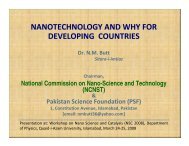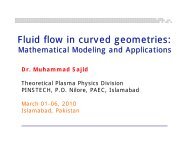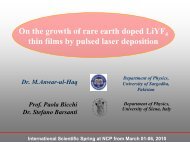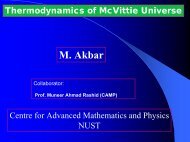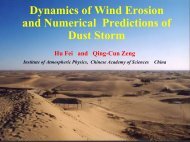Uncertainties in regional climate change - National Centre for Physics
Uncertainties in regional climate change - National Centre for Physics
Uncertainties in regional climate change - National Centre for Physics
You also want an ePaper? Increase the reach of your titles
YUMPU automatically turns print PDFs into web optimized ePapers that Google loves.
Project<strong>in</strong>g future <strong>climate</strong> <strong>change</strong> given futureconcentrations - temperaturePage 3
Project<strong>in</strong>g future <strong>climate</strong> <strong>change</strong> given futureconcentrations - precipitationPage 4
UKCIP ‘02• Based on the state-of-the-artat the time - HadCM3,HadAM3H time-slice, 50kmHadRM3 experiments• Used by many private andpublic-sector organisations tomake decisions and spendmoney• “Scenario” based with noquantification of uncerta<strong>in</strong>ties(although plenty of caveatspo<strong>in</strong>t<strong>in</strong>g this out)Page 5
UKCIP ‘022080temperature<strong>change</strong> (K)2080precipitation<strong>change</strong> (%)We can produce very detailed projections of <strong>climate</strong><strong>change</strong> with no idea of how reliable they might bePage 6
2041-602061-80AOGCMProjected <strong>change</strong><strong>in</strong> summermonsoon ra<strong>in</strong>fall,relative to 1961-90IPCC TARPage 7
UKCIPnext – Aims and Objectives• To provide jo<strong>in</strong>t probability distribution functions (pdfs)of projected <strong>change</strong>s <strong>in</strong> a selection of key UK <strong>climate</strong>variables at 25km resolution <strong>for</strong> each decade dur<strong>in</strong>gthe 21st century• Results will be presented <strong>for</strong> each variable by monthand summarised as quantiles <strong>in</strong>dicat<strong>in</strong>g both meanand extreme outcomes• The set of <strong>climate</strong> variables will be determ<strong>in</strong>ed <strong>in</strong>consultation with stakeholders• We aim to deliver the f<strong>in</strong>al report and the pdfs dur<strong>in</strong>gthe first half of 2008Page 8
Modell<strong>in</strong>g impactsPage 9
GJJ1999Modell<strong>in</strong>g impactsEMISSIONSCONCENTRATIONSCO 2, methane, etc.HEATING EFFECT‘Climate Forc<strong>in</strong>g’.CLIMATE CHANGETemp, ra<strong>in</strong>, sea-level, etc.IMPACTSFlood<strong>in</strong>g, food supply, etc.FeedbacksFeedbacksScenarios frompopulation, energy,economics modelsCarbon cycle andchemistry modelsGas propertiesCoupled <strong>climate</strong>modelsImpacts modelsPage 10
Development of <strong>climate</strong> modelsFrom IPCC TAR, 2001Page 11
Assessment of model uncerta<strong>in</strong>ties• Uncerta<strong>in</strong>ty <strong>in</strong> represent<strong>in</strong>g physical andbiological processes <strong>in</strong> <strong>climate</strong> models1. <strong>Uncerta<strong>in</strong>ties</strong> due to different representations ofprocesses (structural)2. <strong>Uncerta<strong>in</strong>ties</strong> <strong>in</strong> key parameters <strong>in</strong> models3. Omitted processesPage 12
The HadCM3 perturbed physics ensemble• Assessment of the uncerta<strong>in</strong>ty due to the parametrization• Models built us<strong>in</strong>g different values of parameters whose rangesare ill-constra<strong>in</strong>ed• 256 member ensemble with multiple parameter perturbations –atmosphere/slab ocean model, 2xCO 2• Assessment of model quality and global mean <strong>climate</strong>response (i.e. <strong>climate</strong> sensitivity)• Run a 17 member ensemble of coupled model transientexperiments us<strong>in</strong>g “high quality” models with range of <strong>climate</strong>sensitivities – 1860-2100, A1B (flux-adjusted HadCM3)• Additional perturbed model are emulated (Sexton and Rougier,<strong>in</strong> preparation)• Transient response generated by pattern-scal<strong>in</strong>g (Harris et al,2005, EBM based)Page 13
The slab ensemble picture: frequencies ofprojected ra<strong>in</strong>fall <strong>change</strong>s (DJF)Amazon bas<strong>in</strong>Mexico CityBangkok404040Relative likelihood (%)3020103020103020100-50 0 +50Ra<strong>in</strong>fall <strong>change</strong> (%)0-50 0 +50Ra<strong>in</strong>fall <strong>change</strong> (%)0-50 0 +50Ra<strong>in</strong>fall <strong>change</strong> (%)Blue – mean <strong>change</strong>: Red – top 95%ile <strong>change</strong>Page 14
Simple uncerta<strong>in</strong>ty estimatesChanges <strong>in</strong> percentiles <strong>for</strong> T(max) JJA<strong>for</strong> a) Czech republic, b) Great Lakes(USA), c) eastern Ch<strong>in</strong>a and d) SouthernFrance.10-90% spread of the 53 membersensemblesfrom Clark et al, J. Clim, 2006Page 15
Use of obs constra<strong>in</strong>ts: Bayesian framework•Per<strong>for</strong>m a limited ensemble of GCMexperiments with perturbed <strong>in</strong>put parameters•Introduce an emulator which can estimate theGCM output at untried parameter values•Introduce a discrepancy term derived from theoutput of other <strong>climate</strong> models to representstructural uncerta<strong>in</strong>ties•Produce prior predictive distributions of <strong>climate</strong>variables•Use observations to produce a likelihoodfunction and posterior predictive distributionsPage 16
The first example“emulated”priorpredictivedistributionposteriorpredictivedistributionlikelihoodweight<strong>in</strong>g viacomparisonwith real worldhistogram of“perturbed physics”ensembleNo discrepancyMurphy et al., 2004, Nature, 430, 768-772 Page 17
Climate prediction <strong>in</strong>dex (CPI) to select AOGCMsThe choice of themodels:• a reasonablespread <strong>in</strong> <strong>climate</strong>sensitivity• a reasonablygood CPI• a spread <strong>in</strong>model parameterspacePage 18
Global mean temperature response fromHadCM3 ensemblePage 19
Multi-model (MM) and parameter perturbation(PP) ensemble rangesResults <strong>for</strong> 17member HadCM3PP ensemble and21 member IPCCAR4 MM ensembleDFJ precipitation <strong>change</strong> <strong>in</strong> mm/day5% 5% Average Average 95% 95%MME PPE MME PPE MME PPECAM -0.76 -0.54 -0.27 -0.15 0.23 0.26JJA precipitation <strong>change</strong> <strong>in</strong> mm/dayPrecipitation andtemperature<strong>change</strong> <strong>for</strong> CentralAmerica (CAM)5% 5% Average Average 95% 95%MME PPE MME PPE MME PPECAM -0.99 -1.59 -0.44 -0.59 0.11 0.37Annual temperature <strong>change</strong> deg C5% 5% Average Average 95% 95%MME PPE MME PPE MME PPECAM 1.8 2.46 3.2 3.58 4.6 5.02Page 20
Application of HadCM3 ensemble to <strong>climate</strong>scenario generation• For UKCIP08: run 17-member HadRM3 ensemble at 25kmdriven by HadCM3 ensemble and pattern-scale results <strong>for</strong>the 256 slab ensemble• For ENSEMBLES (EU project <strong>for</strong> Europe): run HadRM3and other RCMs driven by HadCM3.0 and high and lowsensitivity members of the full ensemble (i.e. 3experiments) – ensemble augmented with other GCMsand RCMs• Application from other groupsPage 21
ENSEMBLES-EU perturbed physics GCMsMSLP bias DJF (hPa)T bias DJF (K)“unperturbed” HadCM3high sensitivitylow sensitivityPage 22
QUMP predictions at RCM scale• 17 RCM 150-years transient simulations at 25km horizontalresolution• RCMs driven from QUMP GCMs (RCM parameters consistentwith GCM)• Variables from other GCMs will be obta<strong>in</strong>ed by statisticaldownscal<strong>in</strong>g from GCM to RCM scale• Transferability of methodsPage 23
Statistical Downscal<strong>in</strong>g GCM -> RCMK. Brown (unpublished)• SDSM (Wilby et al, 2002)• Daily temperature distribution <strong>for</strong> UK• HadAM3P/HadRM3P simulations(1960-1990 and 2070-2100 A2)• 70% RCM variance expla<strong>in</strong>ed by GCMtemperature• Prelim<strong>in</strong>ary results on precipitation notso goodPage 24
“Local scal<strong>in</strong>g” approachE. Kennett (unpublished)TemperaturePrecipitation50 th percent95 th percent99 th percentPage 25
“Local scal<strong>in</strong>g” approach: effect of GCM resolutionon precipitation - E. Kennett (unpublished)HadCM2 (~300km)HadAM3P (~150km)50 th percent.95 th percent.99 th percent.Page 26
Summary• Methods to estimate uncerta<strong>in</strong>ty <strong>in</strong> <strong>climate</strong> projectionare under development.• Possible problems with the users, impact models notready <strong>for</strong> pdfs of <strong>climate</strong> variables.• Ensembles of <strong>climate</strong> simulations require models withlow computational costs to maximise the number ofperturbed models <strong>in</strong>volved. Sophisticated sampl<strong>in</strong>gstrategies are also needed.Page 27
Thanks!Erasmo.Buonomo@metoffice.gov.ukPage 28



